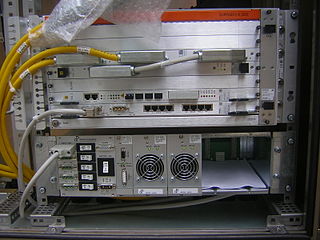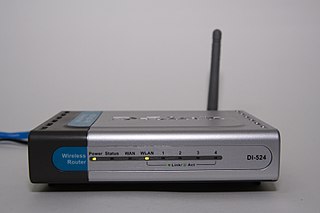Digital subscriber line is a family of technologies that are used to transmit digital data over telephone lines. In telecommunications marketing, the term DSL is widely understood to mean asymmetric digital subscriber line (ADSL), the most commonly installed DSL technology, for Internet access.

A cable modem is a type of network bridge that provides bi-directional data communication via radio frequency channels on a hybrid fibre-coaxial (HFC), radio frequency over glass (RFoG) and coaxial cable infrastructure. Cable modems are primarily used to deliver broadband Internet access in the form of cable Internet, taking advantage of the high bandwidth of a HFC and RFoG network. They are commonly deployed in the Americas, Asia, Australia, and Europe.

Multichannel multipoint distribution service (MMDS), formerly known as broadband radio service (BRS) and also known as wireless cable, is a wireless telecommunications technology, used for general-purpose broadband networking or, more commonly, as an alternative method of cable television programming reception.

A digital subscriber line access multiplexer is a network device, often located in telephone exchanges, that connects multiple customer digital subscriber line (DSL) interfaces to a high-speed digital communications channel using multiplexing techniques. Its cable internet (DOCSIS) counterpart is the cable modem termination system.
Data Over Cable Service Interface Specification (DOCSIS) is an international telecommunications standard that permits the addition of high-bandwidth data transfer to an existing cable television (CATV) system. It is used by many cable television operators to provide cable Internet access over their existing hybrid fiber-coaxial (HFC) infrastructure.
Hybrid fiber-coaxial (HFC) is a broadband telecommunications network that combines optical fiber and coaxial cable. It has been commonly employed globally by cable television operators since the early 1990s.

A cable modem termination system is a piece of equipment, typically located in a cable company's headend or hubsite, which is used to provide data services, such as cable Internet or Voice over IP, to cable subscribers. A CMTS provides many of the same functions provided by the DSLAM in a DSL system.

A wireless router or Wi-Fi router is a device that performs the functions of a router and also includes the functions of a wireless access point. It is used to provide access to the Internet or a private computer network. Depending on the manufacturer and model, it can function in a wired local area network, in a wireless-only LAN, or in a mixed wired and wireless network.

A passive optical network (PON) is a fiber-optic telecommunications network that uses only unpowered devices to carry signals, as opposed to electronic equipment. In practice, PONs are typically used for the last mile between Internet service providers (ISP) and their customers. In this use, a PON has a point-to-multipoint topology in which an ISP uses a single device to serve many end-user sites using a system such as 10G-PON or GPON. In this one-to-many topology, a single fiber serving many sites branches into multiple fibers through a passive splitter, and those fibers can each serve multiple sites through further splitters. The light from the ISP is divided through the splitters to reach all the customer sites, and light from the customer sites is combined into the single fiber. Many fiber ISPs prefer this system.

In the field of telecommunications, the concept of triple play service refers to the provision of three essential services — high-speed broadband Internet access, television, and latency-sensitive telephone services — all delivered over a single broadband connection. This approach emphasizes the convergence of multiple services by a single supplier, aiming to enhance user convenience and streamline service delivery.

A digital subscriber line (DSL) modem is a device used to connect a computer or router to a telephone line which provides the digital subscriber line (DSL) service for connection to the Internet, which is often called DSL broadband. The modem connects to a single computer or router, through an Ethernet port, USB port, or is installed in a computer PCI slot.
DOCSIS Set-top Gateway is a specification describing how out-of-band data is delivered to a cable set-top box. Cable set-top boxes need a reliable source of out of band data for information such as program guides, channel lineups, and updated code images.
In telecommunications, cable Internet access, shortened to cable Internet, is a form of broadband internet access which uses the same infrastructure as cable television. Like digital subscriber line and fiber to the premises services, cable Internet access provides network edge connectivity from the Internet service provider to an end user. It is integrated into the cable television infrastructure analogously to DSL which uses the existing telephone network. Cable TV networks and telecommunications networks are the two predominant forms of residential Internet access. Recently, both have seen increased competition from fiber deployments, wireless, mobile networks and satellite internet access.

Fiber to the x or fiber in the loop is a generic term for any broadband network architecture using optical fiber to provide all or part of the local loop used for last mile telecommunications. As fiber optic cables are able to carry much more data than copper cables, especially over long distances, copper telephone networks built in the 20th century are being replaced by fiber.

In systems management, out-of-band management is a process for accessing and managing devices and infrastructure at remote locations through a separate management plane from the production network. OOB allows a system administrator to monitor and manage servers and other network-attached equipment by remote control regardless of whether the machine is powered on or whether an OS is installed or functional. It is contrasted to in-band management which requires the managed systems to be powered on and available over their operating system's networking facilities.
Zenith Cable Modem was one of the first proprietary cable modems. The two basic models are one operating at 500 kilobits per second (kbit/s), and the other at four megabits per second (Mbit/s) with BPSK and approximately a 25% alpha.
In telecommunications, radio frequency over glass (RFoG) is a deep-fiber network design in which the coax portion of the hybrid fiber coax (HFC) network is replaced by a single-fiber passive optical network (PON). Downstream and return-path transmission use different wavelengths to share the same fiber. The return-path wavelength standard is expected to be 1610 nm, but early deployments have used 1590 nm. Using 1590/1610 nm for the return path allows the fiber infrastructure to support both RFoG and a standards-based PON simultaneously, operating with 1490 nm downstream and 1310 nm return-path wavelengths.
Dell Networking is the name for the networking portfolio of Dell. In the first half of 2013, Dell started to rebrand their different existing networking product brands to Dell Networking. Dell Networking is the name for the networking equipment that was known as Dell PowerConnect, as well as the Force10 portfolio.
Subisu Cablenet Ltd. is a Nepalese Internet Service Provider company located in Kathmandu, Nepal, and was established in 2001. Subisu employs over 1500 full-time employees, of which around 900 are technical and around 700 are non-technical. As of 2023, the company has over 235,000 customers. It has coverage in all 77 districts of Nepal. Subisu primarily provides cable and fiber internet and digital TV services through a hybrid fiber-coaxial (HFCC) network.









